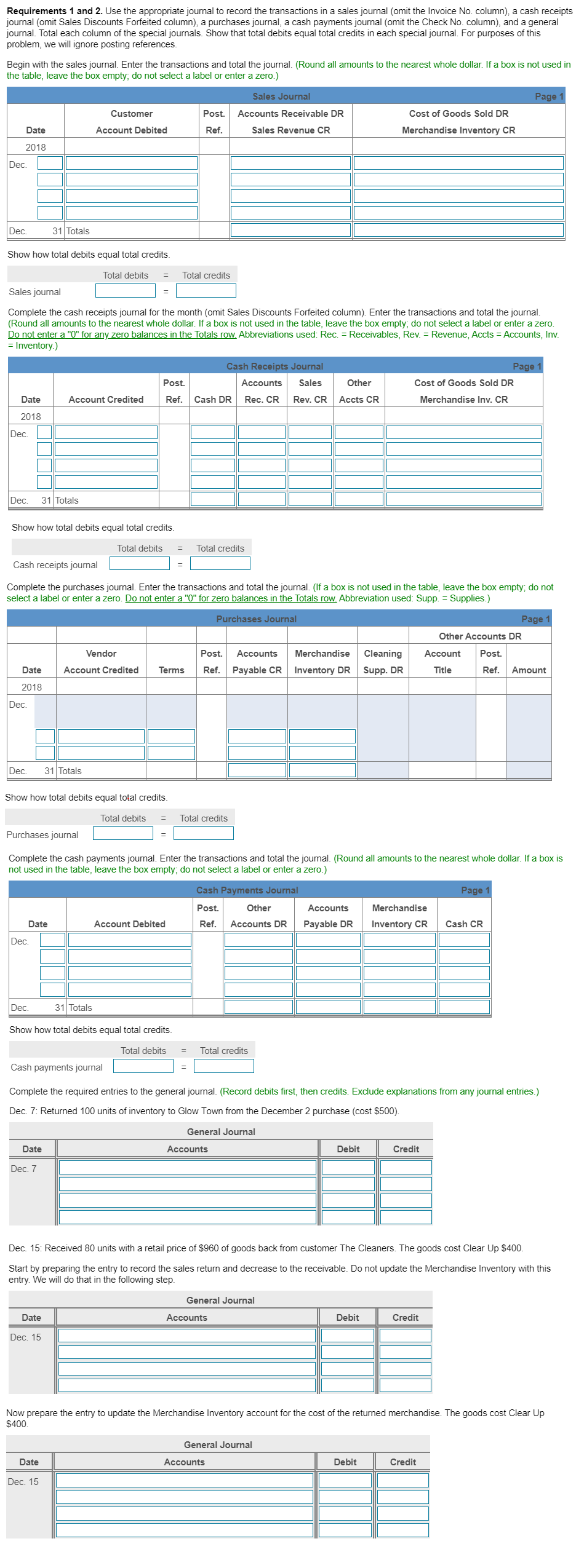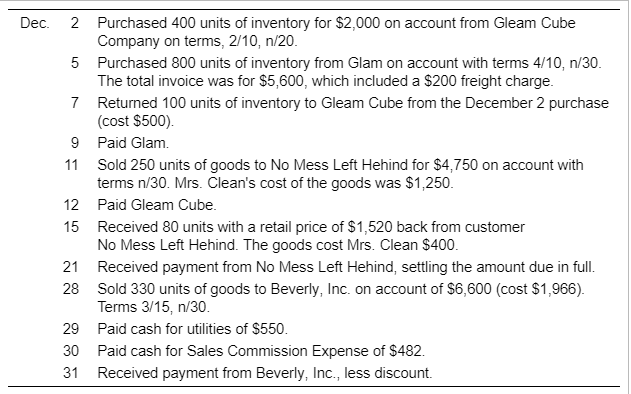Requirements 1 and 2. Use the appropriate journal to record the transactions in a sales journal (omit the Invoice No. column), a cash receipts journal (omit Sales Discounts Forfeited column), a purchases journal, a cash payments journal (omit the Check No. column), and a general journal. Total each column of the special journals. Show that total debits equal total credits in each special journal. For purposes of this problem, we will ignore posting references. Begin with the sales journal. Enter the transactions and total the journal. (Round all amounts to the nearest whole dollar. If a box is not used in the table, leave the box empty; do not select a label or enter a zero.) Sales Journal Page 1 Customer Post. Accounts Receivable DR Cost of Goods Sold DR Date Account Debited Ref. Sales Revenue CR Merchandise Inventory CR 2018 Dec. Dec. 31 Totals Show how total debits equal total credits. Total debits Total credits Sales journal Complete the cash receipts journal for the month (omit Sales Discounts Forfeited column). Enter the transactions and total the journal. (Round all amounts to the nearest whole dollar. If a box is not used in the table, leave the box empty; do not select a label or enter a zero. Do not enter a "0" for any zero balances in the Totals row. Abbreviations used: Rec. = Receivables, Rev. = Revenue, Accts = Accounts, Inv. = Inventory.) Cash Receipts Journal Page Post. Accounts Sales Other Cost of Goods Sold DR Date Account Credited Ref. Cash DR Rec. CR Rev. CR Accts CR Merchandise Inv. CR 2018 Dec. Dec. 31 Totals Show how total debits equal total credits. Total debits Total credits Cash receipts journal Complete the purchases journal. Enter the transactions and total the journal. (If a box is not used in the table, leave the box empty; do not select a label or enter a zero. Do not enter a "0" for zero balances in the Totals row. Abbreviation used: Supp. = Supplies.) Purchases Journal Page Other Accounts DR Vendor Post. Accounts Merchandise Cleaning Account Post. Date Account Credited Terms Ref. Payable CR Inventory DR Supp. DR Title Ref. Amount 2018 Dec. Dec. 31 Totals Show how total debits equal total credits. Total debits Total credits Purchases journal Complete the cash payments journal. Enter the transactions and total the journal. (Round all amounts to the nearest whole dollar. If a box is not used in the table, leave the box empty; do not select a label or enter a zero.) Cash Payments Journal Page 1 Post. Other Accounts Merchandise Date Account Debited Ref. Accounts DR Payable DR Inventory CR Cash CR Dec. Dec. 31 Totals Show how total debits equal total credits. Total debits Total credits Cash payments journal Complete the required entries to the general journal. (Record debits first, then credits. Exclude explanations from any journal entries.) Dec. 7: Returned 100 units of inventory to Glow Town from the December 2 purchase (cost $500). General Journal Date Accounts Debit Credit Dec. 7 Dec. 15: Received 80 units with a retail price of $960 of goods back from customer The Cleaners. The goods cost Clear Up $400. Start by preparing the entry to record the sales return and decrease to the receivable. Do not update the Merchandise Inventory with this entry. We will do that in the following step. General Journal Date Accounts Debit Credit Dec. 15 Now prepare the entry to update the Merchandise Inventory account for the cost of the returned merchandise. The goods cost Clear Up $400. General Journal Date Accounts Debit Credit Dec. 15 2 Purchased 400 units of inventory for $2,000 on account from Gleam Cube Company on terms, 2/10, n/20. 5 Purchased 800 units of inventory from Glam on account with terms 4/10, n/30. The total invoice was for $5,600, which included a $200 freight charge. 7 Returned 100 units of inventory to Gleam Cube from the December 2 purchase (cost $500). 9 Paid Glam. Dec. 11 Sold 250 units of goods to No Mess Left Hehind for $4,750 on account with terms n/30. Mrs. Clean's cost of the goods was $1,250. 12 Paid Gleam Cube. 15 Received 80 units with a retail price of $1,520 back from customer No Mess Left Hehind. The goods cost Mrs. Clean $400. 21 Received payment from No Mess Left Hehind, settling the amount due in full. 28 Sold 330 units of goods to Beverly, Inc. on account of $6,600 (cost $1,966). Terms 3/15, n/30. 29 Paid cash for utilities of $550. 30 Paid cash for Sales Commission Expense of $482. 31 Received payment from Beverly, Inc., less discount.
The Effect Of Prepaid Taxes On Assets And Liabilities
Many businesses estimate tax liability and make payments throughout the year (often quarterly). When a company overestimates its tax liability, this results in the business paying a prepaid tax. Prepaid taxes will be reversed within one year but can result in prepaid assets and liabilities.
Final Accounts
Financial accounting is one of the branches of accounting in which the transactions arising in the business over a particular period are recorded.
Ledger Posting
A ledger is an account that provides information on all the transactions that have taken place during a particular period. It is also known as General Ledger. For example, your bank account statement is a general ledger that gives information about the amount paid/debited or received/ credited from your bank account over some time.
Trial Balance and Final Accounts
In accounting we start with recording transaction with journal entries then we make separate ledger account for each type of transaction. It is very necessary to check and verify that the transaction transferred to ledgers from the journal are accurately recorded or not. Trial balance helps in this. Trial balance helps to check the accuracy of posting the ledger accounts. It helps the accountant to assist in preparing final accounts. It also helps the accountant to check whether all the debits and credits of items are recorded and posted accurately. Like in a balance sheet debit and credit side should be equal, similarly in trial balance debit balance and credit balance should tally.
Adjustment Entries
At the end of every accounting period Adjustment Entries are made in order to adjust the accounts precisely replicate the expenses and revenue of the current period. It is also known as end of period adjustment. It can also be referred as financial reporting that corrects the errors made previously in the accounting period. The basic characteristics of every adjustment entry is that it affects at least one real account and one nominal account.
Mrs. Clean Cleaning has decided that, in addition to providing cleaning services, it will sell cleaning products. Mrs. Clean uses the perpetual inventory system. During December 2018, Mrs. Clean completed the transactions found in the second picture. Complete the


Trending now
This is a popular solution!
Step by step
Solved in 5 steps with 9 images









